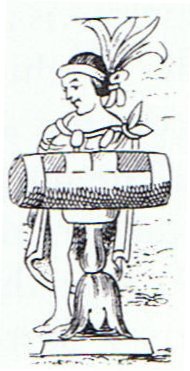What has all this to do with our interpretation of the final
pages of Manuscript E? To try to answer this question I
think it is necessary to once again return to the stations
of the dream-soul of Hau Maka (sleeping soundly in
Hiva):
|
Nga Kope
Ririva Tutuu Vai |
|
A
Te
Taanga |
|
Te Pu Mahore |
Te Poko Uri |
Te
Manavai |
Te
Kioe Uri |
Te
Piringa Aniva |
Te
Pei |
Te
Pou |
Hua Reva |
|
A Hau
Maka O Hiva |
|
7 * 13 = 91 (= 364 /
4) |
91 + 13 = 104 |
... The dream soul went on and came to
Te Piringa Aniva. She named the place 'Te Piringa
Aniva A Hau Maka O Hiva'. Again the dream soul went on
her way and reached Te Pei. She named the place 'Te
Pei A Hau Maka O Hiva'. The dream soul went on and came
to Te Pou. She named the place 'Te Pou A Hau Maka
O Hiva'. The dream soul went on and came to Hua Reva.
She named the place 'Hua Reva A Hau Maka O Hiva'.
The dream soul went on and came to Akahanga. She
named the place 'Akahanga A Hau Maka O Hiva' ...
[E:6-8]
The name Hua Reva was not beginning with the definite
article Te. Thus, here there was a radical change (a break,
pax) in the time sequence:
... He [Eric Thompson] established that one sign, very
common in the [Mayan] codices where it appears affixed to
main signs, can be read as 'te' or 'che',
'tree' or 'wood', and as a numerical classifier in counts of
periods of time, such as years, months, or days. In Yucatec,
you cannot for instance say 'ox haab' for 'three
years', but must say 'ox-te haab', 'three-te
years'. In modern dictionaries 'te' also means
'tree', and this other meaning for the sign was confirmed
when Thompson found it in compounds accompanying pictures of
trees in the Dresden Codex ...
... The [tun] glyph is nearly the
same as that for the month Pax (T549), except that
the top part of the latter is split or divided by two
curving lines. Brinton, without referring to the Pax
glyph, identified the tun glyph as the drum called in
Yucatec pax che (pax 'musical instrument';
che < *te 'wooden). Yucatec pax means
'broken, disappeared', and Quiche paxih means, among
other things, 'split, divide, break, separate'. It would
seem that the dividing lines on the Pax glyph may
have been used as a semantic/phonetic determinative
indicating that the drum should be read pax, not
tun (cf. de Gruyter 1946, p. 27). Thus, one may expect
that this glyph was used elsewhere
meaning 'to break' and possibly for 'medicine' (Yuc. pax,
Tzel., Tzo. pox) ...
Hua means fruit = offspring, and reva means to
project, to get under way, eyelid, flutter in the air, etc:
Hua. 1. Testicle. 2. Figuratively: son, hua tahi,
only son; fruits of the earth; to grow well (of fruits). 3.
To cause a fight, a quarrel. Hua-ai, generation, as
lineage of direct descendents;
contemporaries. Huahua, coccyx of bird, 'parson's nose':
huahua moa, huahua uha. Huataru, a
creeper (Chenopodium ambiguum). Vanaga. 1. The
same; ki hua, again, to continue, to strain, to
struggle, to move, to repeat, over and above. Mq.: hua,
the same, to return, to recommence. 2. To bloom, to sprout;
flower, fruit (huaa); huaa tae oko, huaa
vahio, young fruit; hua atahi, only son;
huahaga, fruit; mei te huahaga o tokoe kopu, the
fruit of thy body; tikea huahaga, deceptive
appearance. P Pau.: ua, to be born; huahaga,
lineage. Mgv.: hua, to produce (said of trees, grain,
etc.), blooming time of flowers, abundance of fruit. Mq.:
hua, to produce, to bear fruit. Ta.: ua, to
sprout. Huahua. 1. Tailless fowl. 2. Vein, tendon,
line. 3. Mgv.: huahua, pimples covering the face.
Ta.: huahua, id. Mq.: hua, tubercules. Sa.:
fuafua, abscess on hand or feet. Ma.: huahua,
small pimples. Pau.: Hua-gakau, rupture. Ta.: ßau,
entrails. Sa.: ga'au, id. Ma.: ngakau, id.
Churchill. 1. Fruit. 2. Egg. 3. Tā
hua = 'genealogical writing' or 'same writing'. Fischer.
Reva. To hang
down; flag, banner. Revareva, 1. To be hanging
vertically; to detach oneself from the background of the
landscape, such a person standing on top of a hill:
ku-revareva-ß te tagata i ruga i te ma˙ga. 2. To cast
itself, to project itself (of shadows); revareva-ß te
kohu o te miro i te maeha o te mahina, the shadow of the
tree casts itself in the light of the moon. 3. Uvula.
Vanaga. To hang, to suspend, flag, banner; hakareva,
to hang up; hakarereva, to hang up, to balance;
hakarevareva, to wave. T Pau.: reva, a flag;
fakarevareva, to hang up, to suspend. Mgv.: reva,
a flag, a signal. Mq.: Úva, to hang up, to be
suspended, to wave a signal. Ta.: reva, a flag,
banner; revareva, to wave. The germ sense is that of
being suspended ... any light object hung up in the island
air under the steady tradewind will flutter; therefore the
specification involved in the wave sense is no more than
normal observation. Churchill. Mgv.: 1. A plant. Ta.:
reva, id. Mq.: eva, id. Sa.: leva, id.
Ma.: rewa-rewa, id. 2. To cross, to pass across
quickly; revaga, departure. Ta.: reva, to go
away, to depart. Ma.: reva, to get under way.
Churchill. Ta.: The firmanent, atmosphere. Ha.: lewa,
the upper regions of the air, atmosphere, the visible
heavens. Churchill. LEWA, s. Haw., the upper
air, region of clouds; v. to swing, float in the air,
move back and forth; hoo-lewa, to vibrate, float in
the air, carry between two persons, as a corpse, a funeral.
Tah., rewa, the firmanent, an abyss; rewa-rewa,
to fly about, as a flag. Mangr., rewa, the
overhanging firmanent, a tent, a flag. N. Zeal., rewa,
the eyelid. Marqu., ewa, to suspend; s. the
middle. Sam., leva (of time), long since; v.
be protracted. Fiji., rewa, high, height;
vaka-rewa, to lift up, to hoist, as a sail. Malg.,
lifa, v. to fan oneself, s. flight;
rafraf, a fan. Goth., luftus, the air. Sax.,
lyfti, air, arch, vault. O. Engl., lift, air.
Lat., limbus (?), fringe, flounce. Sanskr., dev,
div, primarily 'jacere, jaculare', according to A.
Pictet (Orig. Ind.-Eur., ii. 466), subsequently 'to play at
dice', play generally. The permutation of d and l
may be observed in the Latin levir,
brother-in-law (the husband's younger brother) = Sanskr.
devŗi, devara,
id. If dev or
div has derived
the sense of 'throwing dice' from an older sense 'jacere,
jaculare', to throw, to hurl, that sense may be a derivative
from a still older one, 'to lift up, swing about, be
suspended' = the Polynesian lewa,
rewa, 'to be
suspended, to vibrate'. And thus we can also understand the
origin of the Goth. luftus,
the Sax. lyfte,
the O. Norse loft,
Swed. lowera,
lofwa, Engl.
luff. Fornander.
In concentrated form we can
probably find the meaning of the hua reva concept in the Mayan glyph describing where sky and earth are
separating:
... The Maya word cab means earth,
world, tierra, the place below, opposed to caan,
the sky. The overwhelming evidence on the glyph and its
associations in the pictures and texts is for this same
meaning, Earth. A most interesting glyph in this connection
is one found in Maudslay's Tikal, plate 74, glyph 13, our
form 17.33. The text on the stela shows that this glyph
indicates the passage of one day, from 6 Eb, 0 Pop to
7 Eb, 1 Pop; the sun or kin, preceded by the
numeral 1, is seen entering between the caban-sign and what
we shall later come to identify as the sky-glyph ...

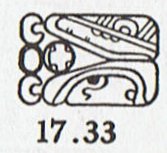
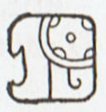
... The numeral 1 has in 17.33 been drawn
like an Oval. The beginning could be perceived as an egg (or
a closed bivalve), carrying the unseen unknown creature
inside representing what would become - the not yet known
future. There was no standard sign for zero time, but
clearly we can see a pair of
'turtle eyes', one above and one below:

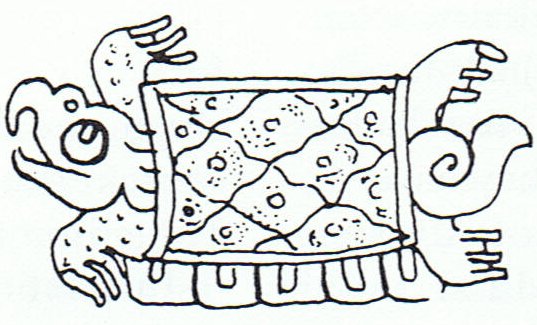
The Mayans were (like the Arabs) reading from right to left and time was thus
beginning when Father Sky (Caan) and Mother Earth (Caban)
were still in close embrace.
... They were Ranginui, the Sky
Father, and Papatuanuku, the Earth Mother, both
sealed together in a close embrace. Crushed between the
weight of their bodies were their many children, whose
oppression deepened. They yearned to be free; they fought
their parents and each other to break loose. Tuumatauenga,
virile god of war, thrust and shouted; Tangaroa of
the oceans whirled and surged; Tawhirirangimaatea,
Haumiatiketike and Rongomatane, of wild foods and
cultivated crops, tried their best but were not successful;
and Ruamoko, god of earthquakes, yet to be born,
struggled in the confinement of his mother's womb ... Of
them all, Taane Mahuta, the god of the forests, was
the most determined; he set his sturdy feet upon his
father's chest, and braced his upper back and shoulders
against the bosom of his mother. He pushed; and they parted.
So the world, as the Maori understand it, came into being
...
The Kin force then separated
them
and time zero (depicted as a closed bivalve) of the new year
in a way was like their offspring (viz. Air).

The mama type of glyph seems to correspond to the
Mayan zero bivalve - although when drawn as separated twin shells
they were no longer closed but
empty:
|
 |
|
mama |
Mama. 1. To chew. 2. To mouth-feed (arch.)
he-mama i te vai t˘a koia ko te tiapito kiroto ki te
haha o te poki, she mouth-feeds the child with
sugarcane juice together with tiapito juice. 3. A
sea mollusc (with an eight-horned shell). Vanaga. 1. To
leak, to ooze, (maamaa). P Pau., Mgv., Ta.:
mama, id. 2. To chew. P Mgv., Mq., Ta.: mama,
id. 3. Light not heavy, (maamaa). P Mgv., Ta.:
mama, id. 4. A limpet (Chiton magnificus).
Mgv., Mq., mama, a shellfish. 5. To open the
mouth; hakamama, to yawn, to gape, to be ajar.
Pau.: hamama, to open. Mgv.: akamama, to
burst open. Ta.: haamama, to open. Mq.:
haßmama, to open the mouth. 6. Ta.: mama-orero,
conclusion of a council. Ha.: mama, to finish, to
have done with a thing. Churchill.
 |
99 |
 |
 |
 |
 |
77 |
 |
|
84 |
*104 |
*105 |
*106 |
*107 |
265 (*185) |
|
ALDEBARAN |
AL SHARAS (The Ribs)
|
... the
distance from Aldebaran to Antares had grown
over time and in 5000 BC the distance from
Aldebaran to Antares was around 177 (= 3 * 59)
nights ... |
ANTARES |
|
MARCH 25 |
JULY 3 |
EQUINOX |
|
"April 17
(107) |
"July 26 |
Tagaroa Uri
15 (288) |
|
May 28 (148) |
Sept 5 (248) |
Nov 25 (329) |
|
181 |
81 |
|
14 * 13 =
182 |
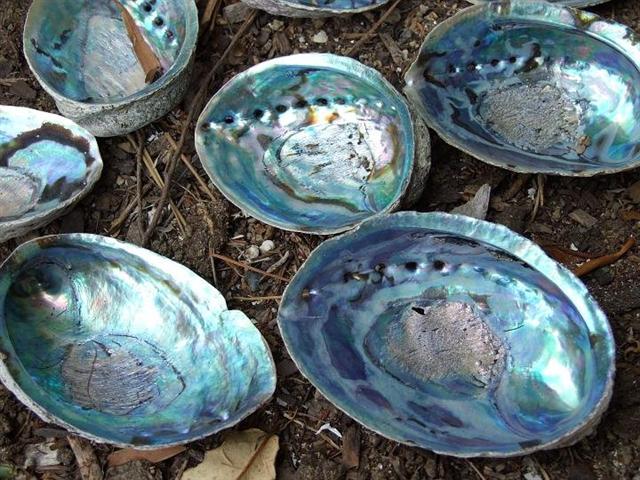
Assuming that I have correctly interpreted the measure 13 days per
dream-soul station, we can then relate Hua Reva to
the days 92 - 104 (alternatively to the days 457 - 469, etc.):
|
Nga Kope Ririva Tutuu Vai |
- |
|
365 |
A Te Taanga |
|
Te Pu Mahore |
1 |
-
13 |
-
378 |
A Hau Maka O Hiva
|
|
Te Poko Uri |
2 |
-
26 |
-
391 |
A Hau Maka I
[Sic!]
Hiva |
|
Te Manavai |
3 |
-
39 |
-
404 |
A Hau Maka O Hiva |
|
Te Kioe Uri |
4 |
- 52 |
- 417 |
|
Te Piringa
Aniva |
5 |
- 65 |
- 430 |
|
Te Pei |
6 |
-
78 |
-
443 |
|
Te Pou |
7 |
-
91 |
-
456 |
|
Hua Reva |
8 |
-
104 |
-
469 |
|
Akahanga |
9 |
- 117 |
- 482 |
|
Hatinga Te Kohe |
10 |
-
130 |
-
495 |
|
Roto Iri Are |
11 |
-
143 |
-
508 |
|
Tama He Ika Kino He Ihu Roroa |
12 |
-
156 |
-
521 |
- |
|
One Tea
|
13 |
-
169 |
-
534 |
A Hau Maka O Hiva |
|
Hanga Takaure |
14 |
-
182 |
-
547 |
|
Poike |
15 |
-
195 |
-
560 |
|
Pua Katiki |
16 |
-
208 |
-
573 |
|
Maunga Teatea |
17 |
- 221 |
- 586 |
|
Mahatua |
18 |
-
234 |
-
599 |
|
Taharoa |
19 |
-
247 |
-
612 |
|
Hanga Hoonu |
20 |
-
260 |
-
625 |
|
Rangi Meamea |
21 |
-
273 |
-
638 |
|
Peke Tau O Hiti |
22 |
-
286 |
-
651 |
|
Maunga Hau Epa |
23 |
-
299 |
-
664 |
|
Oromanga |
24 |
-
312 |
-
677 |
|
Hanga Moria One |
25 |
-
325 |
-
690 |
|
Papa O Pea |
26 |
-
338 |
-
703 |
|
Ahu Akapu |
27 |
- 351 |
- 716 |
|
Te Pito O Te Kainga
|
28 |
-
364 |
-
729 |
And if the Mouth of the Twins corresponded to the first day
of Te Piringa Aniva, we could then count *92
(first day of Hua Reva at the time of
Bharani) - *53 (first day of Te Piringa Aniva at
the time of Bharani) = 39 = 3 * 13, i.e. with glyph
number 30 + 39 = 69 in the G text at the first day of
Hua Reva, and with glyph number 69 + 12 = 81 at the
last day of Hua Reva:
|
CLOSE TO THE SUN: |
|
16 (*26) |
APRIL 17 (472) |
18 (*393) |
19 |
20 (*30) |
21 (111) |
22 |
 |
 |
 |
 |
 |
 |
 |
|
Ga1-26 |
Ga1-27 |
Ga1-28 |
Ga1-29 |
Ga1-30 |
Ga2-1 |
Ga2-2 |
|
μ Orionis (90.3), χ▓ Orionis (90.5) |
6h (91.3 = 273.4 - 182.1)
ν
Orionis
(91.4),
θ
Columbae (91.5),
π
Columbae (91.6)
*50.0 = *91.4 - *41.4 = *232.0 -
*172.0 |
ξ Orionis
(92.5) |
Al Han'ah-4 (Brand) /
Maru-sha-pu-u-mash-mashu-7 (Front of
the Mouth of the Twins)
TEJAT PRIOR
=
η
Gemini
(93.4),
γ
Monocerotis (93.5),
κ
Aurigae (93.6),
κ
Columbae (93.8)
*52.0 = *93.4 - *41.4 |
FURUD
= ζ Canis Majoris
(94.9) |
Well-22 (Tapir) /
Arkū-sha-pu-u-mash-mashu-8
(Back of the Mouth of the Twins)
δ
Columbae (95.2),
TEJAT POSTERIOR
=
μ
Gemini,
MIRZAM (The Roarer) = β Canis
Majoris
(95.4),
CANOPUS
(Canopy) =
α
Carinae
(95.6),
ε
Monocerotis (95.7),
ψ1
Aurigae (95.9)
*54.0 = *95.4 - *41.4 |
no star listed (96) |
|
... The Pythagoreans make Phaeton
fall into Eridanus, burning part of
its water, and glowing still at the
time when the Argonauts passed by.
Ovid stated that since the fall the
Nile hides its sources. Rigveda
9.73.3 says that the Great Varuna
has hidden the ocean. The
Mahabharata tells in its own style
why the 'heavenly Ganga' had to be
brought down. At the end of the
Golden Age (Krita Yuga) a
class of Asura who had fought
against the 'gods' hid themselves in
the ocean where the gods could not
reach them, and planned to overthrow
the government. So the gods implored
Agastya (Canopus, alpha
Carinae = Eridu) for help. The great
Rishi did as he was bidden, drank up
the water of the ocean, and thus
laid bare the enemies, who were then
slain by the gods. But now, there
was no ocean anymore! Implored by
the gods to fill the sea again, the
Holy One replied: 'That water in
sooth hath been digested by me. Some
other expedient, therefore, must be
thought of by you, if ye desire to
make endeavour to fill the ocean ...
 |
|
Te Kioe Uri |
Te
Piringa Aniva |
|
June 19 (170) |
20 (513 / 3) |
SOLSTICE |
22 (*93) |
23 (174) |
ST JOHN'S DAY |
25 |
|
15 |
░June 16 |
17 (168) |
18 |
19 |
20 (*91) |
SOLSTICE |
|
23 |
'May 24 (12 * 12) |
25 (145) |
26 |
27 |
28 (*68) |
29 |
|
9 |
"May 10 (130) |
11 |
12 (*52) |
(*365 + *53 = *418) |
14 |
15 (500) |
|
29 = 170 - 141 |
30 |
31 |
32 |
33 |
34 |
35 |
|
... According to the epoch of
Bharani the star at the Nose of the
Lion had risen heliacally 41 days
earlier (than at the time of
rongorongo), viz. in "June 29 (180 =
*100) = in the day before Sirius.
And at the time of the Bull the date
would similarly have been August 9
(*141) - *64 = *77 (JUNE 6).
|
AL MINHAR AL ASAD |
|
Aug 9 (221 = 80 + *141) |
|
'July 13 (194 = 221 - 27) |
|
"June 29 (180 = 221 - 41) |
|
JUNE 6 (157 = 221 - 64) |
|
221 - 141 = 80 → *0 |
We can identify where for instance
Alcyone would have been in the
tropical year (in the Sun calendar)
at the time when Itzam-Yeh
was defeated:
|
ALCYONE |
84 |
AL MINHAR AL ASAD |
|
May 16 (136 = 80 + 56) |
Aug 9 (221 = 80 + *141) |
|
'April 19 (109 = 136 - 27) |
'July 13 (194 = 221 - 27) |
|
"April 5 (95 = 136 - 41) |
"June 29 (180 = 221 - 41) |
|
MARCH 13 (72 = 136 - 64) |
JUNE 6 (157 = 221 - 64) |
|
136 - 141 = 360 = *280 |
221 - 141 = 80 = *0 |
 |
|
CLOSE TO THE FULL MOON: |
|
OCT 16 |
17 (290) |
18 (*394 - *183) |
19 (475 - 183) |
20 |
21 (*214) |
22 (295) |
 |
 |
 |
 |
 |
 |
 |
|
Ga8-6 (31 + 178) |
Ga8-7 (210) |
Ga8-8 |
Ga8-9 |
Ga8-10 |
Ga8-11
(214) |
Ga8-12 |
|
Winnowing Basket-7 (Leopard)
18h (273.4)
*232.0 = *273.4 - *41.4
NASH
(Point) =
γ
Sagittarii
(273.7),
θ
Arae (273.8) |
ZHŌNGSHĀN =
ο
Herculis
(274.0),
π
Pavonis (274.6) |
ι Pavonis (275.1),
POLIS = μ Sagittarii
(275.9)
MENKAR (α Ceti) |
η Sagittarii (276.9) |
Purva Ashadha-20 (Elephant Tusk,
Fan, Winnowing Basket) |
KAUS BOREALIS = λ Sagittarii
(279.3) |
|
KAUS MEDIUS =
δ
Sagittarii,
κ
Lyrae (277.5),
TUNG HAE (Heavenly Eastern Sea) =
η
Serpentis
(277.7),
SHAOU PIH (Minor Minister) =
φ
Draconis
(277.8),
KWEI SHE =
χ
Draconis
(277.9 |
φ
Oct. (278.1),
KAUS AUSTRALIS =
ε
Sagittarii
(278.3),
ξ
Pavonis (278.4),
AL ATHFAR (The Talons of the
Falling Eagle)
=
μ
Lyrae
(278.6)
*237.0 = *278.4 - *41.4 |

... As has already been mentioned,
the Delphians worshipped Dionysus
once a year as the new-born child,
Liknites, 'the Child in the
Harvest Basket', which was a
shovel-shaped basket of rush and
osier used as a harvest basket, a
cradle, a manger, and a
winnowing-fan for tossing the grain
up into the air against the wind, to
separate it from the chaff. The
worship of the Divine Child was
established in Minoan Crete, its
most famous early home in Europe. In
1903, on the site of the temple of
Dictaean Zeues - the Zeus who was
yearly born in Rhea's cave at Dicte
near Cnossos, where Pythagoras spent
'thrice nine hallowed days' [27] of
his initiation - was found a Greek
hymn which seems to preserve the
original Minoan formula in which the
gypsum-powdered, sword-dancing
Curetes, or tutors, saluted the
Child at his birthday feast. In it
he is hailed as 'the Cronian one'
who comes yearly to Dicte mounted on
a sow and escorted by a
spirit-throng, and begged for peace
and plenty as a reward for their
joyful leaps ... |
|
Dec 19 (*273) |
20 (354) |
SOLSTICE |
22 |
23 (174 + 183) |
X-MAS EVE |
25 (359) |
|
░Dec 15 (*269) |
16 (350) |
17 |
18 |
19 |
20 (354) |
21 |
|
'Nov 22 (*246) |
23 |
24 (328) |
25 |
26 (*250) |
27 |
28 (332) |
|
"Nov 8 |
9 |
10 (314) |
11 |
12 (*236) |
13 |
14 |
|
*273 - *141 |
*133 |
*134 |
*135 |
*136 |
*137 |
*138 |
The first day of Hua Reva was at the
southern winter solstice (*92) according to
my suggested epoch for Bharani and the last
day of Hua Reva (*104) was at
Ga3-22:
|
36 |
CLOSE TO THE SUN: |
|
MAY 29 |
30 |
31 (151) |
JUNE 1 |
2 (*73) |
 |
 |
 |
 |
 |
|
Ga3-10 (345 / 5) |
Ga3-11 (350 / 5) |
Ga3-12 (71 = 355 / 5) |
Ga3-13 (360 / 5) |
Ga3-14 (365 / 5) |
|
γ Pyxidis (133.6) |
ζ
Hydrae (134.1),
ρ
Cancri (134.2),
ζ
Oct.
(134.3), ο Cancri (134.6), δ
Pyxidis (134.9) |
ACUBENS
= α Cancri,
TALITHA BOREALIS = ι Ursae
Majoris
(135.0), σ Cancri (135.2), ρ
Ursa Majoris (135.6) |
ν Cancri (136.0),
TALITHA AUSTRALIS = κ Ursae
Majoris
(136.1), ω Hydrae (136.8) |
9h (137.0)
σ╣ Ursa Majoris (137.0), κ
Cancri (137.3), τ Cancri
(137.4),
ALSUHAIL (al Wazn, of the
Weight) = λ Velorum
(137.5), σ▓ Ursa Majoris
(137.6), τ Ursa Majoris (137.7),
ξ Cancri (137.8)
*96.0 = *137.4 - *41.4 |
|
Talitha,
the First Spring of the Gazelle |
|
Hua Reva |
|
Aug 1 |
2 (182 + 32) |
3 (*365 + *135) |
4 (216) |
5 |
|
░July 28 |
29 (*130) |
30 |
31 |
░Aug 1 |
|
'July 5 |
6 (*107) |
7 |
8 |
9 (190) |
|
SOLSTICE |
"June 22 (*93) |
23 |
ST JOHN'S DAY |
25 |
|
72 |
73 |
74 |
75 = 216 - 141 |
76 |
 |
|
CLOSE TO THE FULL MOON: |
|
NOV 28 |
29 |
30 (*254) |
DEC 1 |
2 (336 = 4 * 84) |
|
μ Aquarii (316.0) |
ε Equulei (317.8) |
no star listed
(318) |
21h (319.6)
ARMUS = η Capricorni
(319.0),
DORSUM = θ Capricorni
(319.3),
TSOO = 24 Capricorni
(319.7) |
DRAMASA
=
σ
Oct.,
χ
Capricorni (320.0),
ν
Aquarii (320.3),
γ
Equulei (320.6),
ο
Pavonis (320.8) |
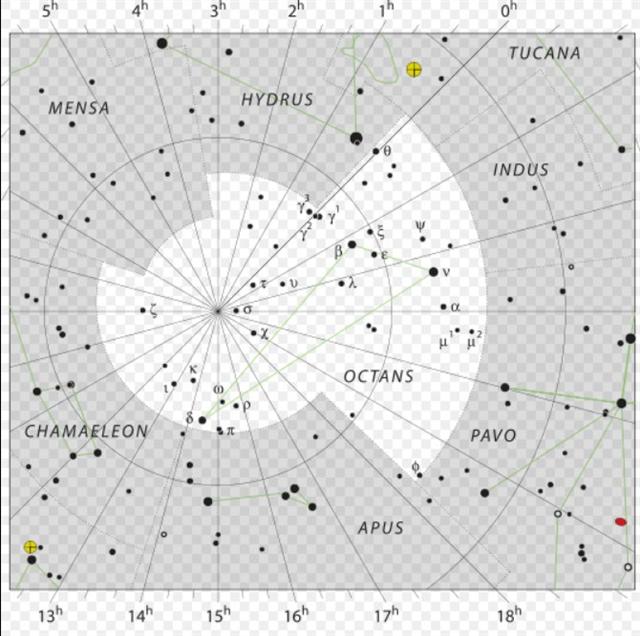 |
|
Jan 31 |
Febr 1 |
2 |
3 |
4 (400 =
80 + 320) |
|
░Jan 27 |
28 |
29 (*314) |
30 |
31 (396) |
|
'Jan 4 |
5 (*290) |
6 |
7 (372) |
8 |
|
SOLSTICE (*275) |
"Dec 22 |
23 |
X-MAS EVE |
25 |
|
*175 = *316 - *141 |
*176 |
*177 |
*178 |
*179 = *320 - *141
|
|
JUNE 3 |
4 (155
= 5 * 31) |
5 (*441 = 9 * 49) |
6 (157 = 221 - 64) |
 |
 |
 |
 |
|
Ga3-15 |
Ga3-16 (75 = 548 - 472) |
Ga3-17 (548 = 441 + 107) |
Ga3-18 (77) |
|
κ Pyxidis (138.0), ε Pyxidis
(138.5) |
π
Cancri (139.2),
MIAPLACIDUS = β Carinae
(139.3),
TUREIS (Little Shield) = ι
Carinae
(139.8) |
no star listed (140) |
θ
Pyxidis (141.5),
MARKAB VELORUM =
κ
Velorum
(141.5),
AL MINHAR AL ASAD
(The Nose of the Lion) =
κ
Leonis
(141.6),
λ
Pyxidis (141.9) |
 |
|
Hua Reva |
|
6 |
7 (584 → Venus) |
Aug 8 (220) |
9 (*141) |
|
2 (214) |
3 |
░Aug 4 (216) |
5 |
|
10 |
11 |
'July 12 (193) |
13 (*114) |
|
26 (177 = 354 / 2) |
27 |
"June 28 (*99) → 2π |
29 (180 = 80 + 100) |
|
77 |
78 |
79 = 220 - 141 |
0h = 80 (= 157 - 77) |
|
CLOSE TO THE FULL MOON: |
|
DEC 3 |
4 |
5 |
6 (340) |
|
α Oct.
(321.5), δ
Equulei (321.7),
φ
Capricorni (321.8) |
KITALPHA (Part of a Horse)
=
α
Equulei
(322.0),
ALDERAMIN (The Right Arm)
= α Cephei
(322.9) |
DAI = ι Capricorni
(323.5),
β
Equulei (323.8) |
γ
Pavonis (324.1),
YAN = ζ Capricorni
(324.6) |
|
5 (36) |
6 |
Febr 7 (403) |
8 (*324) |
|
░Febr 1 |
2 |
░Febr 3 (399) |
4 (*320) |
|
9 |
10 |
'Jan 11 (*296) |
12 (377) |
|
26 (360) |
"Dec 27 |
28 (*282 → 2 * 141) |
29 (363 = 3 * 121) |
|
*180 |
*181 |
*323 - *141 = *182 |
*183 |
|
JUNE 7 (*78) |
8 |
9 |
10 (161) |
11 |
12 |
 |
 |
 |
 |
 |
 |
|
Ga3-19 (78 = 158 - 80) |
Ga3-20 |
Ga3-21 |
Ga3-22 (81) |
Ga3-23 |
Ga3-24 |
|
The Knot (Ukdah) |
5 Imix 9 Kumk'u
Rishu A.-13 (Head of the
Lion)
ψ Leonis (146.4),
RAS ELASET AUSTRALIS
= ε Leonis
(146.6)
*105.0 = *146.4 - *41.4 |
VATHORZ PRIOR = υ
Carinae
(147.9) |
|
Star-25 (Horse) /
ANA-HEU-HEU-PO-5 (Pillar
where debates were held)
ALPHARD
(The Horse) =
α
Hydrae
(142.3),
ω
Leonis (142.6),
τ╣
Hydrae (142.7) |
Al Tarf-7 (The End)
ψ
Velorum (143.3),
ALTERF =
λ Leonis,
τ▓
Hydrae (143.4),
ξ
Leonis (143.5)
*102.0 = *143.4 - *41.4 |
A Hydrae
(144.1)
VEGA (α Lyrae) |
Creation
of our present world
UKDAH
(Knot) = ι Hydrae
(145.4), κ Hydrae
(145.5),
SUBRA = ο Leonis
(145.8)
*104.0 = *145.4 - *41.4
(= *288 - *184) |
|
Itzam-Yeh
defeated |
28
May
(148),
3149
BC |
|
1st
3-stone
place |
21
May
(141),
3114
BC |
|
Creation
of
our
present
world |
13
August
(225),
3114
BC |
|
Och
ta
chan
(Hun-Nal-Ye
'entered
or
became
the
sky') |
5
February
(36),
3112
BC |
|
21
May,
3114
BC -
5
February,
3112
BC =
542 |
|
542
'happens
to
be'
the
sum
of
365
days
and
6 *
29Ż
nights. |
|
|
Hua Reva |
Akahanga |
|
Aug 10 |
11 |
12 |
13 |
14 (*146) |
15 (227 → π) |
|
░Aug 6 |
7 |
8 (220) |
9 |
10 |
11 (*143) |
|
'July 14 |
15 |
16 |
17 (*118) |
18 |
19 (200) |
|
SIRIUS |
"July 1 |
2 |
3 (*104) |
4
(185) |
Te Anakena 5 |
|
81 (= 158 - 77) |
82 |
83 |
84 |
85 = 185 - 100 |
86 = 227 - 141 |
|
...
Makoi replied, 'In Hiva
the land belongs to him
- the land here is mine,
not his [tae oona]!'
They stayed (there
longer). On the fifth
day of the month of July
(Anakena), they
all got up, went
downhill, went on, and
reached Hanga Te Pau.
They took their
provisions with them,
carrying them on their
shoulders, went on, and
reached Te Pou.
They made camp and slept
in Te Pou on the
tenth of the month of
July (Anakena).
Then they all got up,
carried their provision
on their shoulders, went
straight ahead, and
followed the path of the
dream soul of Hau
Maka. They came to
Hua Reva and
said, This is Hua
Reva A Hau Maka!...
(E:21-22) |
|
CLOSE TO THE FULL MOON: |
|
DEC 7 |
8 |
9 |
10 |
11
(345) |
12 (*266) |
|
Al Sa'd al Su'ud-22
(Luckiest of the Lucky)
/
Emptiness-11 (Rat)
TSIN =
36 Capricorni
(325.2),
ALPHIRK (The Flock) =
β
Cephei
(325.7),
SADALSUD
=
β
Aquarii,
ξ
Gruis (325.9) |
no star listed (326) |
CASTRA
= ε Capricorni
(327.2),
BUNDA
= ξ Aquarii
(327.5)
SIRIUS (α Canis Majoris) |
Mahar sha hi-na Shahū-26
(Western One in the Tail
of the Goat)
NASHIRA
=
γ
Capricorni
(328.0),
ν
Oct. (328.3), AZELFAFAGE
=
π╣
Cygni,
κ
Capricorni (328.7) |
Arkat sha hi-na Shahū-27
(Eastern One in the Tail
of the Goat)
ENIF
(The Nose) =
ε
Pegasi, ERAKIS =
μ
Cephei
(329.2),
46 CAPRICORNI,
JIH
(the Sun) =
κ
Pegasi
(329.3),
ι
Piscis Austrini (329.4),
λ
Capricorni (329.6),
ν
Cephei (329.7),
DENEB ALGIEDI
=
δ
Capricorni
(329.8)
*288.0 = *329.4 - *41.4 |
θ Piscis Austrini
(330.1), λ Octantis
(330.7) |
|
Febr 9 (40) |
10 |
11 |
12 (408) |
13 (*329) |
All Hearts' Day |
|
░Febr 5 (36) |
6 |
7 |
8 (*324) |
9 |
10 (41) |
|
'Jan 13 (378) |
14 |
15 (*300) |
16 |
17 |
18 (383) |
|
"Dec 30 |
31 (*285) |
"Jan 1 (366) |
2 |
3 |
4 |
|
*184 = *325 - *141 |
*185 = *285 - *100 |
*(83 + 183 - 80) |
*187 |
*188 |
*189 |
|
